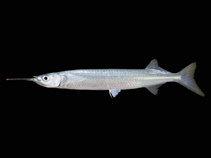| Family: |
Hemiramphidae (Halfbeaks) |
| Max. size: |
35 cm TL (male/unsexed) |
| Environment: |
pelagic-neritic; freshwater; brackish; marine; depth range - 0 m, potamodromous |
| Distribution: |
Indo-West Pacific: Persian Gulf to China along the mainland coast of Asia. Replaced in the East Indies, Borneo, and the Philippines by Hyporhamphus neglectus and around northern Australia and southern New Guinea by Hyporhamphus neglectissimus. |
| Diagnosis: |
Dorsal spines (total): 0-0; Dorsal soft rays (total): 13-16; Anal spines: 0-0; Anal soft rays: 13-16. Greatly prolonged, beak-like lower jaw, equal to, or longer than head length; upper jaw short, triangular and scaly, its width 0.6-0.8 times in its length. Preorbital distance 1.3-2.1 times in diameter of orbit and 0.75-1.2 times in length of upper jaw. Total number of gill rakers on first gill arch 23-37. Anal fin rays 13-16; caudal fin emarginate, not strongly forked. |
| Biology: |
Coastal species. Found at surface levels of tidal freshwaters and brackish estuaries (Ref. 12693). Encountered in the Mekong as far upstream as Stung Treng and also found in the Great Lake, Cambodia (Ref. 12693). Feed mainly on insects (Ref. 12693, 33813). Marketed fresh and dried salted. |
| IUCN Red List Status: |
Least Concern (LC); Date assessed: 17 March 2011 Ref. (130435)
|
| Threat to humans: |
harmless |
Source and more info: www.fishbase.org. For personal, classroom, and other internal use only. Not for publication.
